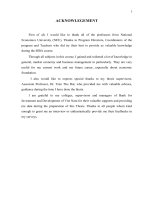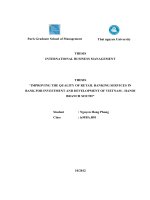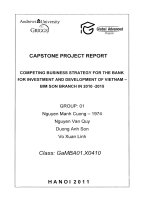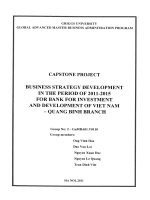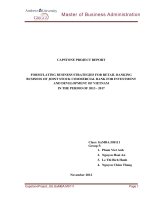Increasing Access to Rural Finance in Bangladesh
Bạn đang xem bản rút gọn của tài liệu. Xem và tải ngay bản đầy đủ của tài liệu tại đây (1.14 MB, 156 trang )
DIRECTIONS IN DEVELOPMENT
Finance
Increasing Access to Rural Finance
in Bangladesh
The Forgotten “Missing Middle”
A study led by Aurora Ferrari
Increasing Access to Rural Finance in
Bangladesh
Increasing Access to Rural
Finance in Bangladesh
The Forgotten “Missing Middle”
© 2008 The International Bank for Reconstruction and Development / The World Bank
1818 H Street NW
Washington DC 20433
Telephone: 202-473-1000
Internet: www.worldbank.org
E-mail:
All rights reserved
1 2 3 4 5 10 09 08 07
This volume is a product of the staff of the International Bank for Reconstruction and
Development / The World Bank. The findings, interpretations, and conclusions expressed in this
volume do not necessarily reflect the views of the Executive Directors of The World Bank or the
governments they represent.
The World Bank does not guarantee the accuracy of the data included in this work. The boundaries, colors, denominations, and other information shown on any map in this work do not imply
any judgement on the part of The World Bank concerning the legal status of any territory or the
endorsement or acceptance of such boundaries.
Rights and Permissions
The material in this publication is copyrighted. Copying and/or transmitting portions or all of
this work without permission may be a violation of applicable law. The International Bank for
Reconstruction and Development / The World Bank encourages dissemination of its work and
will normally grant permission to reproduce portions of the work promptly.
For permission to photocopy or reprint any part of this work, please send a request with complete information to the Copyright Clearance Center Inc., 222 Rosewood Drive, Danvers, MA
01923, USA; telephone: 978-750-8400; fax: 978-750-4470; Internet: www.copyright.com.
All other queries on rights and licenses, including subsidiary rights, should be addressed to the
Office of the Publisher, The World Bank, 1818 H Street NW, Washington, DC 20433, USA;
fax: 202-522-2422; e-mail:
ISBN: 978-0-8213-7333-0
eISBN: 978-0-8213-7334-7
DOI: 10.1596/978-0-8213-7333-0
Cover photos: S. M. A. Hye Shapan, Daily Menabzamin and Andrew Biraj.
Cover design: Quantum Think.
Library of Congress Cataloging-in-Publication Data
Ferrari, Aurora.
Increasing access to rural finance in Bangladesh : the forgotten “missing middle”/by Aurora
Ferrari.
p. cm.
Includes bibliographical references and index.
ISBN 978-0-8213-7333-0—ISBN 978-0-8213-7334-7 (electronic)
1. Rural credit—Bangladesh. 2. Agricultural credit—Bangladesh. 3. Banks and banking—
Bangladesh. 4. Financial institutions—Bangladesh. 5. Rural industries—Bangladesh. I. Title.
HG187.B3F37 2007
332.7’1095492—dc22
2007039297
Contents
Acknowledgments
Abbrevations and Acronyms
Executive Summary
Access to Finance: A Major Constraint on Rural
Growth
Lending to the Missing Middle: Supply-Side
Evidence
Lending to the Missing Middle: Demand-Side
Evidence
Why Have Government Efforts to Increase
Access to Finance Failed for the Missing Middle?
How Can the Government Facilitate Increased
Access to Finance for the Missing Middle?
Chapter 1
The Missing Middle: Supply-Side
Evidence
The Financial Sector
The Banking Sector
xi
xiii
1
2
5
5
7
7
11
11
13
v
vi
Contents
Government Efforts to Increase Rural Credit
Lending to the Missing Middle
16
25
Chapter 2
The Missing Middle: Demand-Side Evidence
Access to Credit for MSMEs
Access to Credit for MSMFs
29
29
32
Chapter 3
Constraints on Increasing Access to Finance
for the Missing Middle
BKB’s and RAKUB’s Deep Insolvency
Challenges for Private Banks
Challenges for Microfinance Institutions
Challenges for Insurance Providers
Serving MSMFs
Chapter 4
39
40
43
51
56
Increasing Access to Finance for the
Missing Middle
Transforming BKB and RAKUB into the Main
Providers of Financial Services in Rural Areas
Helping Banks Serve Rural MSMEs
Helping Microfinance Institutions Scale Up
Lending to the Missing Middle
Promoting Weather Risk Management
for MSMFs
70
Appendix 1
Definitions Used in This Report
Rural Areas
Micro, Small, and Medium-Size Enterprises
Marginal, Small, and Medium-Size Farmers
77
77
77
79
Appendix 2
Comparing Rural Lending in Bangladesh
and India
81
The Rural Micro, Small, and Medium-Size
Enterprise Finance Survey
Survey Questionnaire
Sampling Frame
85
85
86
Appendix 3
61
62
68
70
Contents
Appendix 4
vii
Sample Selection
Focus Group Discussions
Basic Sample Data
86
88
88
Recapitalization Scenarios and Costs of Closing
BKB and RAKUB
Costs of Recapitalizing BKB
Costs of Rehabilitating BKB
Costs of Recapitalizing RAKUB
Costs of Rehabilitating RAKUB
Costs of Closing BKB and RAKUB
91
91
94
95
98
98
Appendix 5
Movable Collateral System
Creation of Security Interests
Priority of Security Interests
Publicity of Security Interests
Enforcement of Security Interests
101
101
102
105
110
Appendix 6
Case Studies of Six Microfinance Institutions
Methodology
Selection of Institutions
The Six Selected Institutions
Lending by the Six Institutions
Financial Performance of the Six Institutions
Growth Prospects of the Six Institutions
115
115
115
116
117
117
125
Bibliography
127
Index
133
Boxes
1
1.1
2.1
2.2
3.1
How Do Natural Disasters Affect Rice Production?
Terms and Conditions of Loans Refinanced under
the Agriculture Refinancing Facility
How Big Is the Potential Market for Providing Credit
to MSMEs?
How Big Is the Potential Market for Providing Credit to
MSMFs?
BRAC Bank—Serving MSMEs
3
18
33
36
50
viii
Contents
3.2
3.3
4.1
4.2
4.3
4.4
4.5
4.6
4.7
ASA’s Microenterprise Programs
BEES’s Product for Marginal and Small Farmers
Khan Bank of Mongolia
Benefits of Having Development-Oriented Investors as
Minority Shareholders
Financial Costs of Alternatives to Rehabilitating BKB
and RAKUB
Banco Procredit’s Expansion into Rural Areas
Using Technology to Improve Financial Access
in Uganda
BASIX and ICICI’s Drought Index Insurance Product
Mexico’s Fund for Natural Disasters
52
54
63
66
67
71
73
74
75
Figures
1
1.1
1.2
1.3
1.4
1.5
1.6
2.1
3.1
3.2
A2.1
A2.2
A2.3
A2.4
A3.1
Most Rural Enterprises Rely on Internal Sources
for Financing
Bank Assets, 1995–2006
Change in Bank Loans and Deposits, 1995–2005
Estimated Rural Loans by Source, 2002 and 2005
Urban and Rural Shares of Bank Loans, 1996–2005
Proportion of Loans to Deposits by Bank Branch
Location, 1996–2005
Distribution of Bank Loans by Purpose, 1996–2005
Collateral Requirements of Banks and Assets of MSMEs
Classification Criteria for Term Loans of Less than
Five Years
Transaction Costs on a 12-Month, 300,000 Taka
Bank Loan
Proportion of Loans to Deposits by Bank Branch
Location, 1996–2005
Urban and Rural Shares of Bank Loans
Distribution of Bank Loans, by Purpose
Estimated Rural Lending by Source, 2005
Bangladesh, with Survey Areas Highlighted
4
13
14
20
22
23
23
32
45
49
82
82
83
83
87
Tables
1
1.1
1.2
1.3
Rural Farming Households and Landholdings
Indicators for Bangladesh’s Financial Sector, 2000–05
Capital Adequacy Ratios of Banks, 2000–05
Returns on Assets and Equity for Banks, 2000–05
2
12
15
16
Contents
1.4
1.5
1.6
1.7
1.8
1.9
1.10
2.1
2.2
2.3
2.4
2.5
2.6
2.7
2.8
2.9
2.10
3.1
3.2
3.3
3.4
3.5
A1.1
A1.2
Nonperforming Loans of Banks, 2000–05
Bank Lending and Deposits in Rural Areas, 2000 and 2005
Average Annual Growth in Urban and Rural Bank Loans,
1996–2005
Summary of Audited Financial Statements for BKB and
RAKUB, 2005
Access Indicators for Private Clients of BKB and
RAKUB, 1996–2005
Microfinance Lending to Micro and Small
Enterprises, 2006
Microfinance Lending to Marginal and Small
Farmers, 2006
Sources of Credit for MSMEs, 2003–06
Returns on Capital for Small and Medium-Size
Enterprises, 2005
Profitability Measures for Small and Medium-Size
Enterprises, 2005
Average Loan Size for MSMEs, 2003–06
Average Lending Terms from Banks, Microfinance
Institutions, and Family and Friends
Top Reasons MSMEs Do Not Apply for Credit
Borrowing Patterns of Farmers, 2000–02
Borrowing Patterns of Farmers with Access to Formal
Credit, 2000–02
Average Size of Most Recent Loan Taken by Farmers,
2000–02
Transaction Costs of Most Recent Loan Taken by Farmers,
2000–02
Selected Data from BKB’s Audited Balance Sheet,
2004–05
Selected Data from RAKUB’s Audited Balance Sheet,
2004–05
Differing Loan Product Preferences for MSMEs
Application Process for Bank Loans to MSMEs
Features of Traditional Crop Insurance and
Index Insurance
Definition of Small and Medium-Size Enterprises
Used by Bangladesh Bank, by Sector
Definition of Small and Medium-Size Enterprises
Used by the Ministry of Industry, by Sector
ix
17
21
22
24
24
25
25
30
30
31
31
31
32
34
35
35
35
42
43
44
48
57
78
78
x
Contents
A1.3
A3.1
A3.2
A3.3
A3.4
A3.5
A4.1
A4.2
A4.3
A4.4
A4.5
A5.1
A5.2
A5.3
A5.4
A6.1
A6.2
A6.3
A6.4
A6.5
Definition of MSMEs Used in This Report
Sectoral Distribution of Sampled Enterprises
Average Number of Employees of Sampled
Enterprises, by Enterprise Size
Legal Status of Sampled Enterprises
Location of Business of Sampled Enterprises
Average Years of Schooling for Owners of Sampled
Enterprises
BKB Recapitalization: Realistic Scenario with 50 Percent
of Standard Loans Carved Out
BKB Recapitalization: Optimistic Scenario with 25 Percent
of Standard Loans Carved Out
RAKUB Recapitalization: Realistic Scenario with 50 Percent
of Standard Loans Carved Out
RAKUB Recapitalization: Optimistic Scenario with
25 Percent of Standard Loans Carved Out
BKB and RAKUB Consolidated Estimated Cost of
Closure
Attributes of Creation in Secured Finance Systems
in Bangladesh and Good Practice Environments
Attributes of Priority in Secured Finance Systems
in Bangladesh and Good Practice Environments
Attributes of Publicity in Secured Finance Systems in
Bangladesh and Good Practice Environments
Attributes of Enforcement in Secured Finance Systems in
Bangladesh and Good Practice Environments
Activities of the Six Selected Microfinance Institutions
Loan Products for MSMFs
Loan Products for MSMEs
Financial Viability Indicators for SOJAG,
CARB, and BEES, 2005–06
Financial Viability Indicators for ASA,
BRAC, and PMUK, Various Years
79
88
88
89
89
89
92
94
95
96
99
103
106
109
111
118
121
123
125
126
Acknowledgments
This report was prepared by a World Bank team led by Aurora Ferrari
under the overall guidance of Simon Bell, Sadiq Ahmed, Christine
Wallich, and Xian Zhu. Major contributors to the report were
Shamsuddin Ahmad, Mukta Joshi, Sadruddin Muhammad Salman, and
Andrew Lovegrove. In addition the team was composed of Richard
Meyer, Olivier Mahul, Mehanz Safavian, Sheela Rahman,
Willian Dick, Henry Bagazonzya, Gabi George Afram, Guillemette
Sidonie Jaffrin, Shah Nur Quayyum, Sukhinder Arora, and Shahnila
Azher. Administrative support was provided by Maria Marjorie Espiritu
and Bridget Rosario. The report was funded by the U.K. Department for
International Development and the World Bank. The report was edited
by Paul Holtz.
The report draws on a Rural Micro, Small, and Medium-size
Enterprises (MSMEs) Finance Survey undertaken jointly by the World
Bank and Business and Finance Consulting (BFC) in association with HB
Consultants. It also draws on the following background papers:
a) “Delivering Finance to MSMEs in Bangladesh,” August 2006, by
Michael Kortenbusch from BFC; b) “Microfinance Products for Small and
Medium Farmers and Micro and Small Enterprises: Challenges and
Opportunities for MFIs in Bangladesh,” April 2007, by Dewan Alamgir
xi
xii
Acknowledgments
and Richard Meyer, which is based on six MFI case studies conducted
by the authors; and c) “Bangladesh Crop Index-Based Insurance: A
Feasibility Study,” July 2006, by William Dick, Ornsaran Pomme
Manuamorn, and SARMAP.
The peer reviewers were Renate Kloeppinger-Todd, Nathan M. Belete,
and Akbar Ali Khan.
The report incorporates extensive suggestions and comments from
representatives of the government of Bangladesh, Palli Karma Sahayyak
Foundation (PKSF) staff and its participating organizations, and
Bangladeshi financial institutions who attended workshops in Dhaka in
September 2006, April 2007, and July 2007, at which the findings of the
report were presented and discussed.
Abberviations and Acronyms
ASA
BASIC
BEES
BFC
BKB
BRAC
BRDB
BSB
BSBL
BSRS
CARB
GDP
ICICI
MELA
MFI
MSME
MSMF
PKSF
a prominent Bangladeshi microfinance institution; the
word means “hope”
Bank of Small Industries and Commerce
Bangladesh Extension Education Services
Business and Finance Consulting
Bangladesh Krishi Bank
Bangladesh Rural Advancement Committee
Bangladesh Rural Development Board
Bangladesh Shilpa Bank
Bangladesh Samabaya Bank Limited
Bangladesh Shilpa Rin Sangtha
Center for Action Research–Barind
gross domestic product
India’s largest private commercial bank (formerly Industrial
Credit and Investment Corporation of India)
Micro Enterprise Lending and Assistance
microfinance institution
micro, small, and medium-size enterprise
marginal, small, and medium-size farmer
Palli Karma Sahayyak Foundation
xiii
xiv
Abbrevations and Acronyms
PMUK
RAKUB
SBC
SBL
SEL
SOJAG
SREESTI
Padakhep Manobik Unnayan Kendra (Padakhep Center for
Human Development)
Rajshahi Krishi Unnayan Bank
Sadharan Bima Corporation
Small Business Loan
Small Enterprise Loan
Samaj O Jathi Gathan
Sustainable Refinancing for Enterprises and Technology
Improvement (product of PMUK)
Currency Equivalents
US$1 = 69 taka (as of June 17, 2007)
Executive Summary
Three-quarters of Bangladesh’s people live in rural areas, and more than
40 percent of this population lives below the poverty line—making the
rural sector central to the country’s development. Micro, small, and
medium-size enterprises (MSMEs) and marginal, small, and medium-size
farmers (MSMFs)—together referred to in this report as the “missing
middle”—are the engines of growth in rural Bangladesh, in terms of both
current employment and contributions to gross domestic product
(GDP) and possible prospects for future development.
In 2004 nonagricultural activities employed 40 percent of rural workers and accounted for more than 50 percent of rural households’ income
(World Bank 2004). Most of these activities are conducted by MSMEs.
Such enterprises help diversify rural incomes by reducing households’
vulnerability to weather and seasonality in agriculture. With limited
opportunities for creating employment in agriculture, and if an appropriate enabling environment is developed, these enterprises could continue
to grow and will lead Bangladesh’s rural economy.
Though becoming less important, farming still plays a major role in the
rural economy. The sector employs 54 percent of rural workers (Bangladesh
Bureau of Statistics 2000a) and accounts for nearly 21 percent of national
GDP.1 Crops account for the lion’s share (57 percent) of agricultural GDP.
1
2
Increasing Access to Rural Finance in Bangladesh
Table 1. Rural Farming Households and Landholdings
Classification
Landless
Landless
Marginal
Marginal
Small
Medium
Large
Land owned
(acres)
<0.05
0.05–0.49
0.5–0.99
1.0–1.49
1.5–2.49
2.5–7.49
7.5+
Rural households
Number (millions) Share (percent)
6.40
3.56
2.58
1.86
1.99
2.20
0.32
Share of operated
land area (percent)
33.8
18.8
13.7
9.9
10.5
11.6
1.7
0.0
4.5
8.5
10.3
17.9
41.5
17.3
Source: Agricultural Census of Bangladesh 1996/97.
About 45 percent of Bangladeshi farmers own between 0.5 and 7.5
acres of land—making them marginal, small, or medium-size (table 1).
More than half of farmers own less than 0.5 acre of land and are
considered landless. With their extremely limited landholdings and
highly volatile incomes, such farmers can make only a limited contribution to rural growth. Indeed, future agricultural growth will depend
on intensifying current practices, expanding irrigated areas, and diversifying into higher-value crops—all of which require landholdings larger
than 0.5 acre.
Access to Finance: A Major Constraint on Rural Growth
Considerable investment is needed for Bangladesh’s agriculture sector to
become more commercial and for its nonagricultural activities to grow.
MSMEs and MSMFs not only need access to finance for investment, they
also need it in a timely fashion to take advantage of market and investment
opportunities. And given the high weather risk inherent in agricultural
investments, financial institutions need to be able to transfer part of that
risk to profitably lend to the segment.
Yet 53 percent of rural enterprises (both agricultural and nonagricultural) consider access to finance a major or very severe obstacle to
their operations (World Bank 2003). Making matters worse, no agricultural insurance scheme exists in Bangladesh. About two-thirds of the
financing (working capital and new investment) needs of both small
and medium-size enterprises are met through internal funds or
retained earnings (figure 1). Thus most enterprises rely on household
and business savings to expand—even for working capital. Although
this might be the best solution in the current environment, there are
limits to equity-financed growth.
Executive Summary
Box 1
How Do Natural Disasters Affect Rice Production?
Flooding is a recurrent event in Bangladesh. Most of its territory consists of
floodplains, and up to 30 percent of the country experiences annual flooding
during the monsoon season—while periodic extreme floods affect 60 percent
of the national territory. Although annual flooding is beneficial, severe flooding
hurts the population and causes major losses in rice production.
Rice crops have, however, become less susceptible to flood damage as the
area planted with deepwater aman rice (grown on flood-prone land during the
monsoon season) has fallen and boro rice (which can be produced five to six
months after a flood-damaged rice harvest) has been planted more extensively.
Production losses caused by floods mainly affect aus and aman (rainfed) rice,
while losses for boro rice are limited to unusual events. For example, the 2000
flood caused an estimated loss of 305,482 metric tons of aman and only 7,920 metric tons of boro. Losses caused by cyclones follow the opposite pattern, with boro
rice most affected. For example, it is estimated that cyclones in 2000 caused a loss
of 318,460 metric tons of boro and no damage to aus and aman crops.
Bangladesh is also vulnerable to recurrent droughts. Some 2.3 million
hectares are prone to drought, and between 1960 and 1991 droughts occurred
19 times. Two critical dry periods are distinguished:
• Rabi and pre-Karif drought (between January and May), due to the cumulative
effects of dry days, higher temperatures during pre-Karif, and low availability of
soil moisture.
• Karif droughts (between June/July and October), created by sub-humid and
dry conditions in the country’s highlands and medium highlands. Rainfall
shortages affect the critical reproductive stages of the transplanted aman
crop in December, reducing its yield—particularly in areas with where soil
has low moisture-holding capacity.
Western regions are especially vulnerable to droughts. During the Rabi season 1.2 million hectares of cropland face droughts of various magnitudes, and a
severe drought can damage more than 40 percent of broadcast aus. During the
Kharif season drought causes significant damage to the transplanted aman
crop on about 2.3 million hectares. In addition to causing agricultural losses,
droughts significantly increase land degradation.
Source: Bureau of Statistics data.
3
4
Increasing Access to Rural Finance in Bangladesh
Figure 1. Most Rural Enterprises Rely on Internal Sources for Financing
70
small
60
medium-size
percent
50
40
30
20
10
0
internal
family informal
fund and friends sources
equity
NGOs
private remittances trade
bank
credit
state
institution
Source: World Bank 2003.
Increasing access to rural finance is often the last frontier for financial
sector development in developing countries. Financial institutions aiming to operate in rural areas in these countries usually have to deal with
high transaction costs, low population densities, remote areas, and a
heavy focus on agriculture, with related weather and commodity risks
(box 1). Although Bangladesh is highly vulnerable to natural disasters—
including floods, droughts, and cyclones—its high population density
lowers transaction costs considerably (though not entirely).
This report seeks to:
• Measure the quantity and quality of access to finance by rural MSMEs
and MSMFs. In Bangladesh these are also referred to as the “missing middle”—a segment not served by banks or microfinance institutions (MFIs).
• Identify constraints that financial institutions face in serving MSMEs
and MSMFs. The institutions analyzed in detail include, Bangladesh
Krishi Bank (BKB), Rajshahi Krishi Unnayan Bank (RAKUB), MFIs,
private banks, and insurance companies. These institutions have been
selected because they are among the largest providers of finance to the
missing middle. Moreover, given their size, they have a considerable
impact on the current dysfunction of rural financial markets.
• Develop a realistic strategy and options for sustainably increasing access
to finance for the missing middle.
Executive Summary
5
Lending to the Missing Middle: Supply-Side Evidence
Bangladesh’s banking sector has grown quickly since 1995, with bank assets
growing by nearly 23 percent a year between 1995 and 2005. Moreover, the
banking sector grew faster than GDP during this period, with loans rising
from 21 to 30 percent of GDP and deposits jumping from 26 to 39 percent
of GDP. Yet this expansion has not really benefited the missing middle.
Over the years the government has introduced several initiatives aimed
at facilitating rural credit in general, and lending to the missing middle in
particular. These include:
• Creating BKB in 1973 and RAKUB in 1987 to serve rural areas and
the Bank of Small Industries and Commerce (BASIC) in 1988 to promote small-scale industries in rural and urban areas.
• Promoting two systems of cooperatives since 1972.
• Providing refinance facilities to institutions interested in financing
agriculture.
• Introducing a policy encouraging banks—especially private ones—to
expand their branches and activities in rural areas.
• Creating a multiperil crop insurance scheme and waiving principal
and interest on small agricultural loans from state banks and cooperatives in case of natural disasters.
But government efforts to increase access to finance have had mixed
results. The importance of banks and cooperatives in rural lending has
declined, while the importance of MFIs has increased. Bank intermediation
in rural areas remains limited, with banks transferring 0.5 taka to urban areas
for each 1 taka in deposits collected in rural areas. The largest providers of
agricultural loans, BKB and RAKUB, are deeply insolvent, and BASIC and
the cooperative system are irrelevant in terms of rural loans. Finally, since the
closure of the government-sponsored crop insurance scheme, insurance
companies have been almost completely absent from rural markets.
No data are available on bank lending to MSMEs and MSMFs, but evidence indicates that such lending is limited. Moreover, the microfinance
sector—traditionally the largest provider of small loans in rural areas—has
remained focused on the landless poor with group loans involving weekly
repayments. Such products are not suitable for MSMEs and MSMFs.
Lending to the Missing Middle: Demand-Side Evidence
A 2006 survey of rural MSMEs found that despite substantial use of
bank services among these enterprises (43 percent had an account, and
6
Increasing Access to Rural Finance in Bangladesh
75 percent made transfers), during 2003–06 only 32 percent borrowed
from banks. During the same period 16 percent of these enterprises borrowed from MFIs and 8 percent from informal sources (mainly family
and friends)—while 44 percent did not borrow at all. When borrowing
from banks, the average loan for such enterprises is 400,000 taka, while
their average loan from MFIs is 38,000 taka.
These firms financed 88 percent of their working capital needs using
retained earnings and internal funds, and only 33 percent used debt to
finance new investments. Thus, instead of borrowing, most MSMEs
expand their activities only after building up internal resources.
Micro, small, and medium-size enterprises do not seem to be
excluded from financial markets because of poor financial performance. Indeed, such enterprises have strong returns on capital and robust
long-term profitability. Instead, they seem to be excluded due to a gap
in the financial market.
When asked why they did not apply for credit, 40 percent of these
enterprises cited the high costs, direct and indirect. Direct costs include
interest rates and other transaction costs (such as for documentation,
including financial statements, titles, and the like). Indirect costs include
long processing times (which translate into missed business opportunities)
and intensive application processes requiring many meetings between
borrowers and banks (again translating into missed opportunities). Once
all the required documents have been submitted, it takes an average of
40 days to get a loan from a bank and 28 days from an MFI. In addition, the
survey found that banks mainly require immovable assets as primary collateral in 86 percent of cases, while movable assets account for 73 percent
of the average asset value of MSMEs.
Similarly, a 2002 agricultural credit survey found that 34–40 percent
of medium-size farmers (depending on their acreage) have no access to
credit. The survey showed that larger farmers tend to borrow from formal
and informal sources more than small farmers do. About 22 percent of
landless farmers had formal or informal loans, compared with 38 percent
of large farmers.
Not surprisingly, access to bank credit increases with farm size, while
access to microcredit decreases. But the average loan per acre declines
with increasing farm acreage. In line with this, farmers that use both
bank and informal loans borrow less from banks than from informal
sources. As with MSMEs, the total cost of borrowing for MSMFs is much
higher, on average, than is advertised by banks. Advertised annual interest
rates range from 8 to 12 percent, while the total cost of borrowing
(including transport, documentation, and bribes) is closer to 25 percent.
Executive Summary
7
Why Have Government Efforts to Increase Access to Finance
Failed for the Missing Middle?
BKB and RAKUB, which are supposed to be the main providers of financial
services in rural areas, are deeply insolvent. A government refinance
facility that should have facilitated agricultural lending has instead
become the main source of funding for BKB and RAKUB’s growing capital
deficits, and agricultural lending is falling—compromising their capacity
to serve the missing middle.
Private banks have high enough earnings from corporate lending that
they have limited appetite to expand into rural areas. Although required
to open one rural branch for every four in urban areas, private banks use
rural branches to collect deposits that are then used for loans in urban
areas. Most lending opportunities in rural areas involve MSMEs and
MSMFs, which banks cannot serve profitably under the current legal and
regulatory framework and with current lending methodologies. Although
lending profitably to these enterprises is not easy, doing so for such farmers is even more challenging because of the difficulties that agricultural
lending presents—including weather risks. But such markets are harder to
serve profitably with traditional approaches to agricultural insurance due
to the lack of financial capacity among rural households, lack of distribution channels, low unit size of transactions, and high operating costs.
Finally, while MFIs operate in rural areas, they focus on the landless
and do not have appropriate lending methodologies to serve larger, more
complex clients.
How Can the Government Facilitate Increased Access to Finance
for the Missing Middle?
A number of policies could increase access to finance for the missing
middle. This report offers suggestions that are considered the most pragmatic in the current environment, that have been proven in similar
circumstances in other countries, and that could lead to tangible
improvements for the missing middle.
Given the historical significance of BKB and RAKUB, any solution to
increasing services in rural areas—especially for MSMFs—will necessarily
involve these institutions. Their current market-distorting behavior only
reinforces the importance of tackling their underlying problems.
In addition to reforming the publicly sponsored financial sector,
other useful steps could be taken to facilitate the participation of private financial institutions and MFIs in increasing access to financial
8
Increasing Access to Rural Finance in Bangladesh
services for the missing middle. If the right enabling environment were
created with appropriate lending methodologies, private banks could
become the main lenders to MSMEs—especially for the top end of the
market. But given the current stage of development of the rural banking
market, it seems unlikely that private banks will lend to MSMFs in the
near future.
With suitable products and technology, MFIs could scale up their
lending to MSMEs and MSMFs—especially micro and small enterprises
and marginal and small farmers. Indeed, such institutions are likely to
focus on the bottom end of these market segments, at least in the
medium term.
Finally, with the right enabling environment and development of the
right products, the insurance sector could absorb some commercial agricultural risk. In addition, uninsurable financial risk could be covered by
the government in a disciplined fashion.
To help banks increase lending to MSMEs, the government could:
• Reform the enabling environment for MSME lending by reviewing
rules on provisioning requirements, reforming and implementing a new
legal framework for secured transactions, and strengthening the credit
bureau’s operations.
• Create a technical assistance fund to help selected banks with potential
to develop appropriate products and procedures for MSMEs.
To help MFIs increase lending to MSMEs and MSMFs, the government
could:
• Set up a technical assistance fund to increase lending to the missing
middle, by introducing new products and lending technologies and
appropriate management information systems.
To help BKB and RAKUB become the main providers of rural financial
services, the government could:
• Reform and recapitalize both banks.
To facilitate risk transfer for institutions lending to MSMFs, the government could:
• Remove the legal and regulatory obstacles to the development of
index-based weather insurance.
Executive Summary
9
• Promote the creation of a technical assistance unit that helps interested
institutions develop new index-based insurance products.
• Create a Fund for Natural Calamities to cover risk that is not commercially viable.
Note
1. The industrial sector accounts for 27 percent and the service sector, 52 percent
(World Bank, World Development Indicators database 2006).

